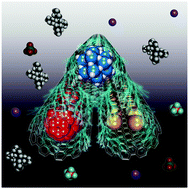Electrochemistry of redox-active molecules confined within narrow carbon nanotubes
Abstract
Confinement of molecules within nanocontainers can be a powerful tool for controlling the states of guest-molecules, tuning properties of host-nanocontainers and triggering the emergence of synergistic properties within the host–guest systems. Among nanocontainers, single-walled carbon nanotubes – atomically thin cylinders of carbon, with typical diameters below 2 nm and lengths reaching macroscopic dimensions – are ideal hosts for a variety of materials, including inorganic crystals, and organic, inorganic and organometallic molecules. The extremely high aspect ratio of carbon nanotubes is complemented by their functional properties, such as exceptionally high electrical conductivity and thermal, chemical and electrochemical stability, making carbon nanotubes ideal connectors between guest-molecules and macroscopic electrodes. The idea of harnessing nanotubes both as nanocontainers and nanoelectrodes has led to the incorporation of redox-active species entrapped within nanotube cavities where the host-nanotubes may serve as conduits of electrons to/from the guest-molecules, whilst restricting the molecular positions, orientations, and local environment around the redox centres. This review gives a contemporary overview of the status of molecular redox chemistry within ultra-narrow carbon nanotubes (nanotubes with diameters approaching molecular dimensions) highlighting the opportunities, pitfalls, and gaps in understanding of electrochemistry in confinement, including the role of nanotube diameter, size and shape of guest-molecules, type of electrolyte, solvent and other experimental conditions.

- This article is part of the themed collection: Nanoconfinement


 Please wait while we load your content...
Please wait while we load your content...